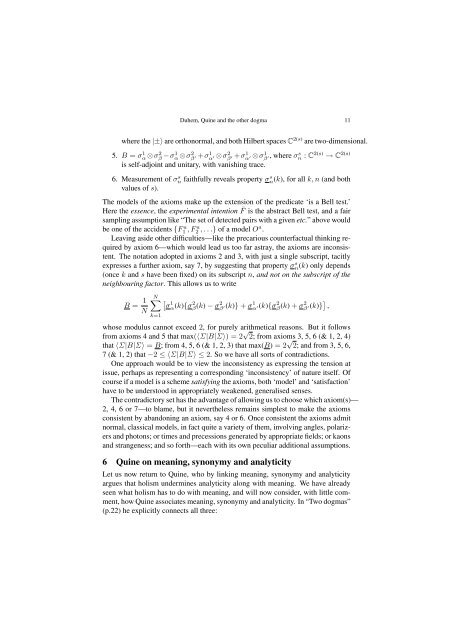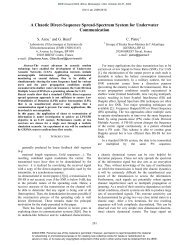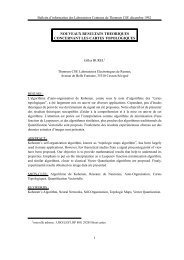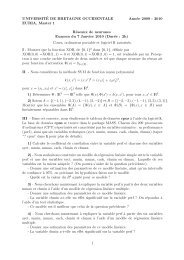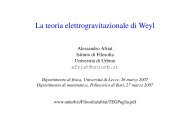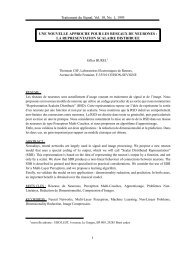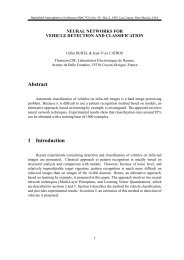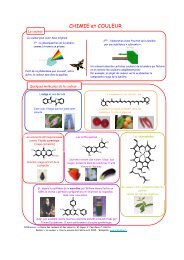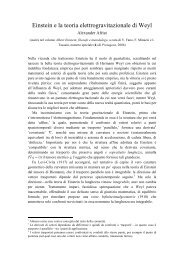Duhem, Quine and the other dogma
Duhem, Quine and the other dogma
Duhem, Quine and the other dogma
- No tags were found...
You also want an ePaper? Increase the reach of your titles
YUMPU automatically turns print PDFs into web optimized ePapers that Google loves.
<strong>Duhem</strong>, <strong>Quine</strong> <strong>and</strong> <strong>the</strong> o<strong>the</strong>r <strong>dogma</strong> 11<br />
where <strong>the</strong> |±〉 are orthonormal, <strong>and</strong> both Hilbert spaces C 2(s) are two-dimensional.<br />
5. B = σ 1 α ⊗σ 2 β −σ1 α ⊗σ 2 β ′ +σ1 α ′ ⊗σ2 β ′ +σ1 α ′ ⊗σ1 β ′, where σs n : C 2(s) → C 2(s)<br />
is self-adjoint <strong>and</strong> unitary, with vanishing trace.<br />
6. Measurement of σn s faithfully reveals property σ s n (k), for all k, n (<strong>and</strong> both<br />
values of s).<br />
The models of <strong>the</strong> axioms make up <strong>the</strong> extension of <strong>the</strong> predicate ‘is a Bell test.’<br />
Here <strong>the</strong> essence, <strong>the</strong> experimental intention ¯F is <strong>the</strong> abstract Bell test, <strong>and</strong> a fair<br />
sampling assumption like “The set of detected pairs with a given etc.” above would<br />
be one of <strong>the</strong> accidents {F1 a , F2 a , . . .} of a model O a .<br />
Leaving aside o<strong>the</strong>r difficulties—like <strong>the</strong> precarious counterfactual thinking required<br />
by axiom 6—which would lead us too far astray, <strong>the</strong> axioms are inconsistent.<br />
The notation adopted in axioms 2 <strong>and</strong> 3, with just a single subscript, tacitly<br />
expresses a fur<strong>the</strong>r axiom, say 7, by suggesting that property σ s n (k) only depends<br />
(once k <strong>and</strong> s have been fixed) on its subscript n, <strong>and</strong> not on <strong>the</strong> subscript of <strong>the</strong><br />
neighbouring factor. This allows us to write<br />
B = 1 N<br />
N∑ [<br />
σ<br />
1<br />
α (k){σ 2 β (k) − σ2 β ′(k)} + σ1 α ′(k){σ2 β (k) + σ2 β ′(k)}] ,<br />
k=1<br />
whose modulus cannot exceed 2, for purely arithmetical reasons. But it follows<br />
from axioms 4 <strong>and</strong> 5 that max(〈Σ|B|Σ〉) = 2 √ 2; from axioms 3, 5, 6 (& 1, 2, 4)<br />
that 〈Σ|B|Σ〉 = B; from 4, 5, 6 (& 1, 2, 3) that max(B) = 2 √ 2; <strong>and</strong> from 3, 5, 6,<br />
7 (& 1, 2) that −2 ≤ 〈Σ|B|Σ〉 ≤ 2. So we have all sorts of contradictions.<br />
One approach would be to view <strong>the</strong> inconsistency as expressing <strong>the</strong> tension at<br />
issue, perhaps as representing a corresponding ‘inconsistency’ of nature itself. Of<br />
course if a model is a scheme satisfying <strong>the</strong> axioms, both ‘model’ <strong>and</strong> ‘satisfaction’<br />
have to be understood in appropriately weakened, generalised senses.<br />
The contradictory set has <strong>the</strong> advantage of allowing us to choose which axiom(s)—<br />
2, 4, 6 or 7—to blame, but it never<strong>the</strong>less remains simplest to make <strong>the</strong> axioms<br />
consistent by ab<strong>and</strong>oning an axiom, say 4 or 6. Once consistent <strong>the</strong> axioms admit<br />
normal, classical models, in fact quite a variety of <strong>the</strong>m, involving angles, polarizers<br />
<strong>and</strong> photons; or times <strong>and</strong> precessions generated by appropriate fields; or kaons<br />
<strong>and</strong> strangeness; <strong>and</strong> so forth—each with its own peculiar additional assumptions.<br />
6 <strong>Quine</strong> on meaning, synonymy <strong>and</strong> analyticity<br />
Let us now return to <strong>Quine</strong>, who by linking meaning, synonymy <strong>and</strong> analyticity<br />
argues that holism undermines analyticity along with meaning. We have already<br />
seen what holism has to do with meaning, <strong>and</strong> will now consider, with little comment,<br />
how <strong>Quine</strong> associates meaning, synonymy <strong>and</strong> analyticity. In “Two <strong>dogma</strong>s”<br />
(p.22) he explicitly connects all three:


